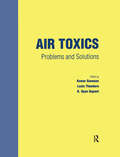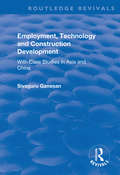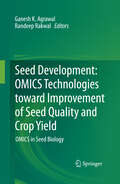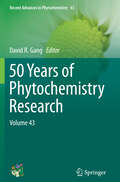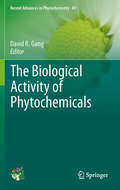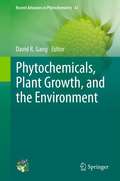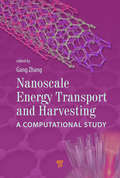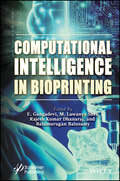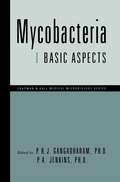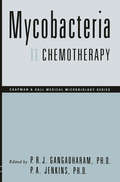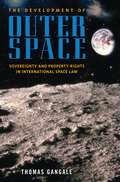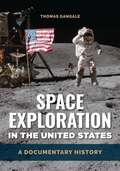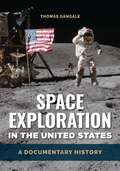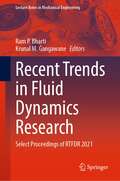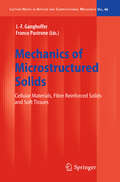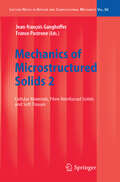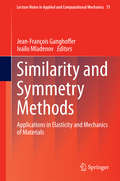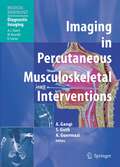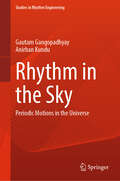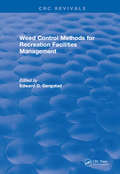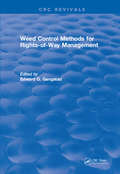- Table View
- List View
Air Toxics: Problems and Solutions
by Kumar GanesanThis timely new workbook is the result of a year-long effort by a group of university professors who first met at Montana Tech during the summer of 1994 for a college faculty workshop. The workshop was funded by the National Science Foundation's support for those faculty developing courses in the newly emerging field of air toxics. Part I of the book contains over 100 problems dealing with a variety of topics in this area. Part II provides detailed solutions. The problems and solutions provided will become a useful resource for the training of engineers and scientists who are or soon will be working in the field.
Air Toxics: Problems and Solutions
by Kumar GanesanThis timely new workbook is the result of a year-long effort by a group of university professors who first met at Montana Tech during the summer of 1994 for a college faculty workshop. The workshop was funded by the National Science Foundation's support for those faculty developing courses in the newly emerging field of air toxics. Part I of the book contains over 100 problems dealing with a variety of topics in this area. Part II provides detailed solutions. The problems and solutions provided will become a useful resource for the training of engineers and scientists who are or soon will be working in the field.
Employment, Technology and Construction Development: With Case Studies in Asia and China (Routledge Revivals)
by Sivaguru GanesanThis title was first published in 2000: An in depth analysis of employment and technology issues in the housing and construction industries of developing countries, in the context of globalization of economies and increased opportunities for advanced technology transfer. Supported by case studies from Asia including the misallocation of resources that led to the Asian crisis of 1997 and the experience of Shanghai in advanced technology transfer. Ganesan advances a number of strategies to achieve higher employment creation, a proper mix of resources and sustained growth.
Employment, Technology and Construction Development: With Case Studies in Asia and China (Routledge Revivals)
by Sivaguru GanesanThis title was first published in 2000: An in depth analysis of employment and technology issues in the housing and construction industries of developing countries, in the context of globalization of economies and increased opportunities for advanced technology transfer. Supported by case studies from Asia including the misallocation of resources that led to the Asian crisis of 1997 and the experience of Shanghai in advanced technology transfer. Ganesan advances a number of strategies to achieve higher employment creation, a proper mix of resources and sustained growth.
Seed Development: OMICS in Seed Biology
by Ganesh K. Agrawal and Randeep RakwalThe book is about the seed development in the model and crop plants. Seed development is a key step of the plant life cycle that determines the nutrient value of seeds – the life for human civilization, growth, and development. The nutrient value of seeds is mainly due to storage reserve products such as carbohydrates, lipids (triacylglycerols), and proteins. The book primarily focuses on application of the 21st century high-throughput technologies transcriptomics, proteomics, metabolomics, and systems biology in near complete understanding of the various processes involved in seed development in different crop plants. The book reveals how such technologies have revolutionized our understanding of the multilayer processes and regulations involved therein by generating large-scale datasets. Accumulated datasets provide basic knowledge to develop integrated strategies to eventually improve the nutritional value of plant seed and crop yield, a critical goal in food security issues around the globe.
50 Years of Phytochemistry Research: Volume 43 (Recent Advances in Phytochemistry #43)
by David R GangThis 43rd volume of RAP includes a total of seven articles based on talks presented at the 50th Anniversary meeting of the PSNA, which was held at the Fairmont Orchid, in Waikoloa, Hawai’i, USA. These seven Perspectives give a very good picture of the breadth of plant (bio)chemistry research in North America, which is also indicative of the state of the field worldwide. Each of these articles describes the integration of several different approaches to ask and then answer interesting questions regarding the function of interesting plant metabolites, either in the plant itself or in interactions with the environment (natural setting or human health application). Two Perspectives outline very clearly the power of approaching biological questions from a modern, “omics” or systems biology approach. Beale and Ward outline how metabolomics approaches can be brought to bear on plant biosynthetic questions and quickly lead to important advances in our understanding or how plants produce important metabolites. Zandkarimi et al. outline the integration of ion mobility spectrometry into mass spectrometry-based metabolomics investigations and show clearly how powerful those two spectrometric technologies can be when used together.
The Biological Activity of Phytochemicals (Recent Advances in Phytochemistry #41)
by David R. GangThis is the first volume to be published under a new series agreement for Recent Advances in Phytochemistry, co-published with the Phytochemical Society of North America.
Phytochemicals, Plant Growth, and the Environment (Recent Advances in Phytochemistry #42)
by David R. GangThis is the second volume since the reintroduction of the Recent Advances in Phytochemistry (RAP) series, an annual journal supported by the Phytochemical Society of North America. Topics appropriate for RAP include the biosynthesis of natural products and regulation of metabolism, the ecology of specialized metabolites and the evolution of their pathways, and the effects of natural products or plants on human health. Research appropriate for RAP involves genomics, proteomics, metabolomics, natural product structural determination and new technology development, medicinal chemistry and metabolic engineering, or any of the myriad of fields that are now closely associated with what may be called “traditional phytochemistry” and plant biochemistry. The advent of post-genomics-based ways of thinking, of systems biology, of synthetic biology, of comparative genomics/ proteomics/ transcriptomics/ metabolomics and especially of the introduction and establishment of a mentality that leads to support of large collaborative projects, has opened up many new doors to scientists interested and versed in the (bio)chemistry of plants. The goal of RAP is to highlight these developments. Two main types of articles are printed in RAP: Perspectives and Communications. Perspectives in RAP are expected to synthesize results from the primary literature and perhaps from new/novel results and place these in perspective relative to the broader field. These articles may be similar to review articles, but also are intended to present important ideas and hypotheses, and may present proposals for interesting directions in the field. It is the hope of the Editorial Board that these articles will be of great value to a large audience. Communications are intended to represent new advances in the field that will be of interest to a large audience. Articles of both types are typically solicited from the Society membership based on the content of the annual meeting talks, but in keeping with the title “Recent Advances in Phytochemistry” the editorial board reserves the right to solicit additional Perspectives and/or Communications from non-attendees as well (e.g., where an editorial board member has knowledge of an interesting recent advancement that would be of general interest to the society membership). All submissions to RAP go through a rigorous peer review process, overseen by the Editorial Board, which includes external review. RAP is indexed with Springer published journals. All RAP papers are available not only in the published volume form, but also electronically through Springer’s online literature services. This marks a significant change from past volumes of RAP and it is the hope of the Editorial Board that this will lead to broader dissemination of the contents of and greater interest in RAP. This 42nd volume of RAP includes a total of seven articles, many, but not all, based on talks presented at the 50th annual meeting of the PSNA. As was seen in RAP volume 41, These seven Perspectives give a very good picture of the breadth of plant (bio)chemistry research in North America, which is also indicative of the state of the field worldwide. Each of these articles describes the integration of several different approaches to ask and then answer interesting questions regarding the function of interesting plant metabolites, either in the plant itself or in interactions with the environment (natural setting or human health application). Many of these Perspectives have a strong ecological focus. McCormick et al. review the discovery of the biosynthetic pathway leading to production of trichothecene mycotoxins such as the T-2 toxin in plant pathogenic and other fungi. These compounds play very important roles in plant-pathogen interaction, and are very significant from a human health perspective. In a complementary paper, Duringer et al. describe recent technological advances in monitoring mycotoxins such as ergovaline and lysergic acid in forage crops, using state of the art and highly sensitive mass spectrometric means. Gross reviews the current un
Nanoscale Energy Transport and Harvesting: A Computational Study
by Zhang GangEnergy transport and conversion in nanoscale structures is a rapidly expanding area of science. It looks set to make a significant impact on human life and, with numerous commercial developments emerging, will become a major academic topic over the coming years. Owing to the difficulty in experimental measurement, computational simulation has becom
Computational Intelligence in Bioprinting: Challenges and Future Directions
by E. Gangadevi M. Lawanya Shri Rajesh Kumar Dhanaraj Balamurugan BalusamyCOMPUTATIONAL INTELLIGENCE IN BIOPRINTING The book provides a comprehensive exploration of the evolving field of bioprinting in regenerative medicine and is an essential guide for professionals seeking a thorough understanding of the field. Computational Intelligence in Bioprinting provides a comprehensive overview of the evolving field of bioprinting in reformative medicine, defining the process of printing structures using viable cells, biomaterials, and living molecules. The primary goal is to provide substitutes for tissue implants, which might lead to eliminating the requirement for organ donors, as well as to transform animal testing for the learning and analysis of disease and the growth of treatments. The book offers a comprehensive overview of bioprinting technologies and their applications, emphasizing the integration of computation intelligence, artificial intelligence, and other computer science advancements in the field. By harnessing the power of computational intelligence techniques such as AI, machine learning, optimization algorithms, and data analytics, existing hurdles can be overcome and the full potential of bioprinting can be unlocked. The book covers an extensive range of topics, including bio-ink formulation and characterization, bioprinter hardware and software design, tissue and organ modeling, image analysis, process optimization, and quality control. Audience The book is aimed at professionals, practitioners and researchers in the fields of bioprinting, tissue engineering, and computational intelligence in medicine.
Computational Intelligence in Bioprinting: Challenges and Future Directions
by E. Gangadevi M. Lawanya Shri Rajesh Kumar Dhanaraj Balamurugan BalusamyCOMPUTATIONAL INTELLIGENCE IN BIOPRINTING The book provides a comprehensive exploration of the evolving field of bioprinting in regenerative medicine and is an essential guide for professionals seeking a thorough understanding of the field. Computational Intelligence in Bioprinting provides a comprehensive overview of the evolving field of bioprinting in reformative medicine, defining the process of printing structures using viable cells, biomaterials, and living molecules. The primary goal is to provide substitutes for tissue implants, which might lead to eliminating the requirement for organ donors, as well as to transform animal testing for the learning and analysis of disease and the growth of treatments. The book offers a comprehensive overview of bioprinting technologies and their applications, emphasizing the integration of computation intelligence, artificial intelligence, and other computer science advancements in the field. By harnessing the power of computational intelligence techniques such as AI, machine learning, optimization algorithms, and data analytics, existing hurdles can be overcome and the full potential of bioprinting can be unlocked. The book covers an extensive range of topics, including bio-ink formulation and characterization, bioprinter hardware and software design, tissue and organ modeling, image analysis, process optimization, and quality control. Audience The book is aimed at professionals, practitioners and researchers in the fields of bioprinting, tissue engineering, and computational intelligence in medicine.
Mycobacteria: I Basic Aspects
by Pattisapu R.J. Gangadharam P.A. JenkinsMycobacteria is divided into two volumes. The first volume deals with the basic biology of mycobacteria. With its emphasis on the state of the art outlook, this volume includes taxonomy and molecular biology of mycobacteria, modern approaches for detection of mycobacteria, and immunology and immunization against tuberculosis. The second volume covers drug trestments for mycobacteria anad tuberculosis. It outlines trends of discovery and development of chemotherapy, starting from the mid-50's to present day uses of chemotherapy in treating AIDS, drug-resistant tuberculosis, and other non-tuberculosis mycobacterial diseases.
Mycobacteria: II Chemotherapy (Chapman & Hall medical microbiology series)
by Pattisapu R.J. Gangadharam P.A. JenkinsMycobacteria is divided into two volumes. The first volume deals with the basic biology of mycobacteria. With its emphasis on the state of the art outlook, this volume includes taxonomy and molecular biology of mycobacteria, modern approaches for detection of mycobacteria, and immunology and immunization against tuberculosis. The second volume covers drug trestments for mycobacteria anad tuberculosis. It outlines trends of discovery and development of chemotherapy, starting from the mid-50's to present day uses of chemotherapy in treating AIDS, drug-resistant tuberculosis, and other non-tuberculosis mycobacterial diseases.
The Development of Outer Space: Sovereignty and Property Rights in International Space Law (Non-ser.)
by Thomas GangaleThis account of the evolution of outer space law examines key issues that fuel the debates over sovereignty and property rights designed to govern the future colonization and use of heavenly bodies other than our own.In the United States, lobbies for the commercial development of space have become increasingly antagonistic toward the international legal regime of outer space, condemning the 1967 Outer Space Treaty and the unratified 1979 Moon Agreement as anti-business. The Development of Outer Space: Sovereignty and Property Rights in International Space Law argues that the res communis principle enshrined in the Outer Space Treaty was misrepresented here, with essential help from corporate lobbyists whose real object was the defeat of the Law of the Sea Convention. Thomas Gangale builds the legal case for reviving the moribund Moon Agreement as a prelude to negotiating a second Moon treaty to establish a regulatory regime for the exploitation of extraterrestrial resources.The author's account of the inception and evolution of outer space law to date is deeply informed by his appreciation of such terrestrial considerations as the nation-state system, the contending economic theories of capitalism and communism, and the post-colonial struggle between the developed space-faring nations and the developing earthbound nations.
Space Exploration in the United States: A Documentary History
by Thomas GangaleThis select volume of historical documents is organized chronologically, spanning from 1914 to the present. Divided into eight chapters, it includes a narrative introduction to each historical period.This collection of historical documents provides insight into the history of the United States in its pursuit of the peaceful uses of outer space, with emphasis on the manned space program of the National Aeronautics and Space Administration, as well as commercial American activities supporting human spaceflight in the early 21st century. Rocketry and space technology have served varied goals throughout the Space Age: pure research, as well as research applied for national security, national prestige, and commercial profit. There have been varied actors as well, among them individuals supported by philanthropists as well as governments, intergovernmental organizations, international consortiums, and for-profit corporations. This book focuses on space exploration, and in particular, human space exploration, leading to the questions, "Why have humans gone into outer space in the past?" and "Why will they do so in the future?" These documents help readers to examine the variety of fascinating answers to those questions.
Space Exploration in the United States: A Documentary History
by Thomas GangaleThis select volume of historical documents is organized chronologically, spanning from 1914 to the present. Divided into eight chapters, it includes a narrative introduction to each historical period.This collection of historical documents provides insight into the history of the United States in its pursuit of the peaceful uses of outer space, with emphasis on the manned space program of the National Aeronautics and Space Administration, as well as commercial American activities supporting human spaceflight in the early 21st century. Rocketry and space technology have served varied goals throughout the Space Age: pure research, as well as research applied for national security, national prestige, and commercial profit. There have been varied actors as well, among them individuals supported by philanthropists as well as governments, intergovernmental organizations, international consortiums, and for-profit corporations. This book focuses on space exploration, and in particular, human space exploration, leading to the questions, "Why have humans gone into outer space in the past?" and "Why will they do so in the future?" These documents help readers to examine the variety of fascinating answers to those questions.
Recent Trends in Fluid Dynamics Research: Select Proceedings of RTFDR 2021 (Lecture Notes in Mechanical Engineering)
by Krunal M. Gangawane Ram P. BhartiThis book presents select proceedings of Conference on Recent Trends in Fluid Dynamics Research (RTFDR-21). It signifies the current research trends in fluid dynamics and convection heat transfer for both laminar and turbulent flow structures. The topics covered include fluid mechanics and applications, microfluidics and nanofluidics, numerical methods for multiphase flows, cavitation, combustion, fluid-particle interactions in turbulence, biological flows, CFD, experimental fluid mechanics, convection heat transfer, numerical heat transfer, fluid power, experimental heat transfer, heat transfer, non-newtonian rheology, and boundary layer theory. The book also discusses various fundamental and application-based research of fluid dynamics, heat transfer, combustion, etc., by theoretical and experimental approaches. The book will be a valuable reference for beginners, researchers, and professionals interested in fluid dynamics research and allied fields.
Mechanics of Microstructured Solids: Cellular Materials, Fibre Reinforced Solids and Soft Tissues (Lecture Notes in Applied and Computational Mechanics #46)
by J. F. Ganghoffer Franco PastroneMechanics of Microstructured Solids 2: Cellular Materials, Fibre Reinforced Solids and Soft Tissues (Lecture Notes in Applied and Computational Mechanics #50)
by J. F. Ganghoffer Franco PastroneThis second volume of the series Lecture Notes in Applied and Computational Mechanics is the second part of the compendium of reviewed articles presented at the 11th EUROMECH-MECAMAT conference entitled "Mechanics of microstructured solids: cellular materials, fibre reinforced solids and soft tissues", which took place in Torino (Italy) in March 10-14, 2008, at the Museo Regional delle Scienze. This EUROMECH-MECAMAT conference was jointly organized by the Dipartimento di Matematica dell'Università di Torino, Italy and the INPL Institute (LEMTA, Nancy-Université, France). Prof. Franco Pastrone and Prof. Jean-François Ganghoffer were the co-chairmen.
Similarity and Symmetry Methods: Applications in Elasticity and Mechanics of Materials (Lecture Notes in Applied and Computational Mechanics #73)
by Jean-François Ganghoffer Ivaïlo MladenovThe principle aim of the book is to present a self-contained, modern account of similarity and symmetry methods, which are important mathematical tools for both physicists, engineers and applied mathematicians. The idea is to provide a balanced presentation of the mathematical techniques and applications of symmetry methods in mathematics, physics and engineering.That is why it includes recent developments and many examples in finding systematically conservation laws, local and nonlocal symmetries for ordinary and partial differential equations.The role of continuous symmetries in classical and quantum field theories is exposed at a technical level accessible even for non specialists. The importance of symmetries in continuum mechanics and mechanics of materials is highlighted through recent developments, such as the construction of constitutive models for various materials combining Lie symmetries with experimental data.As a whole this book is a unique collection of contributions from experts in the field, including specialists in the mathematical treatment of symmetries, researchers using symmetries from a fundamental, applied or numerical viewpoint.The book is a fascinating overview of symmetry methods aimed for graduate students in physics, mathematics and engineering, as well as researchers either willing to enter in the field or to capture recent developments and applications of symmetry methods in different scientific fields.
Imaging in Percutaneous Musculoskeletal Interventions (Medical Radiology)
by Afshin Gangi V. Baert Harry K. Genant Stephane Guth Ali Guermazi George Y. El-KhouryThis book details imaging in percutaneous musculoskeletal interventions. It describes in exhaustive detail the abilities and uses of imaging in guiding procedures ranging from biopsy and joint injection to management of pain and tumors. In addition, it documents the different indications for vascular interventions in musculoskeletal lesions and focuses on ultrasound-guided interventions.
Rhythm in the Sky: Periodic Motions in the Universe (Studies in Rhythm Engineering)
by Gautam Gangopadhyay Anirban KunduThis book provides a brief and pedagogic introduction to a variety of topics, with a common motif that they all occur, in some way or other, in “the sky”, and involve some sort of “rhythm”. Sky is not just the inside of a dome; there are many strata, each with its own beauties and mysteries. As we go up, the atmosphere thins out and ends, and we move into the space, into the realms of planets, asteroids, and comets, and even further, beyond the solar system into the vast Milky Way galaxy. This is where the night sky comes in, with all its twinkling stars, the stars in our own galaxy. We must use telescopes to explore further. In this book, we will start from the ancient astronomers and how they studied the motion of earth through space. Study of planetary orbits, from Kepler and Newton to Einstein, had been fascinating. We will try to take the reader through the wonderful worlds of the cepheid variables and pulsars to the strange oscillations of the neutrinos and the new eye to look at the universe, namely the gravitational waves. The book stops at the discovery of the black hole at the center of our galaxy, but that is just because we must stop somewhere, or the assortment could go on ad infinitum. Some of these topics are highly mathematical in nature, but we will try to avoid the complicated mathematics as much as possible, without compromising with the rigor.
Weed Control Methods For Recreation Facilities Management
by Edward O. GangstadIt is the purpose of this volume to survey and assess the management problems of recreation waters and to present case problems from the field in which the technical data, published literature, and the operations mechanics are given in sufficient detail to provide a format for practical analysis and application. Special emphasis has been given to measures of control of Eurasian watermilfoil.The primary and secondary uses of a body of water determine the need, frequency, and kind of aquatic plant control required to meet the needs of a specific situation. That is to say, a given body of water may be used primarily, or even exclusively for such activities as fishing, boating, or swimming, and the water itself may be used for domestic (potable water), industrial production, and/or agriculture. These uses may seem to be incompatible in themselves, but it is incumbent upon management to supply the optimum conditions for total water use.
Weed Control Methods For Recreation Facilities Management
by Edward O. GangstadIt is the purpose of this volume to survey and assess the management problems of recreation waters and to present case problems from the field in which the technical data, published literature, and the operations mechanics are given in sufficient detail to provide a format for practical analysis and application. Special emphasis has been given to measures of control of Eurasian watermilfoil.The primary and secondary uses of a body of water determine the need, frequency, and kind of aquatic plant control required to meet the needs of a specific situation. That is to say, a given body of water may be used primarily, or even exclusively for such activities as fishing, boating, or swimming, and the water itself may be used for domestic (potable water), industrial production, and/or agriculture. These uses may seem to be incompatible in themselves, but it is incumbent upon management to supply the optimum conditions for total water use.
Weed Control Methods for Rights of Way Management
by Edward O. GangstadThis volume describes in detail methods of control and related data including (1) all vegetation on industrial sites, paved highways, and railroad ballast, (2) woody vegetation along roadsides, utility lines, and fire breaks, and (3) aquatic vegetation on rivers and stream banks, waterways, ponds, reservoirs, irrigation, and drainage channels.
